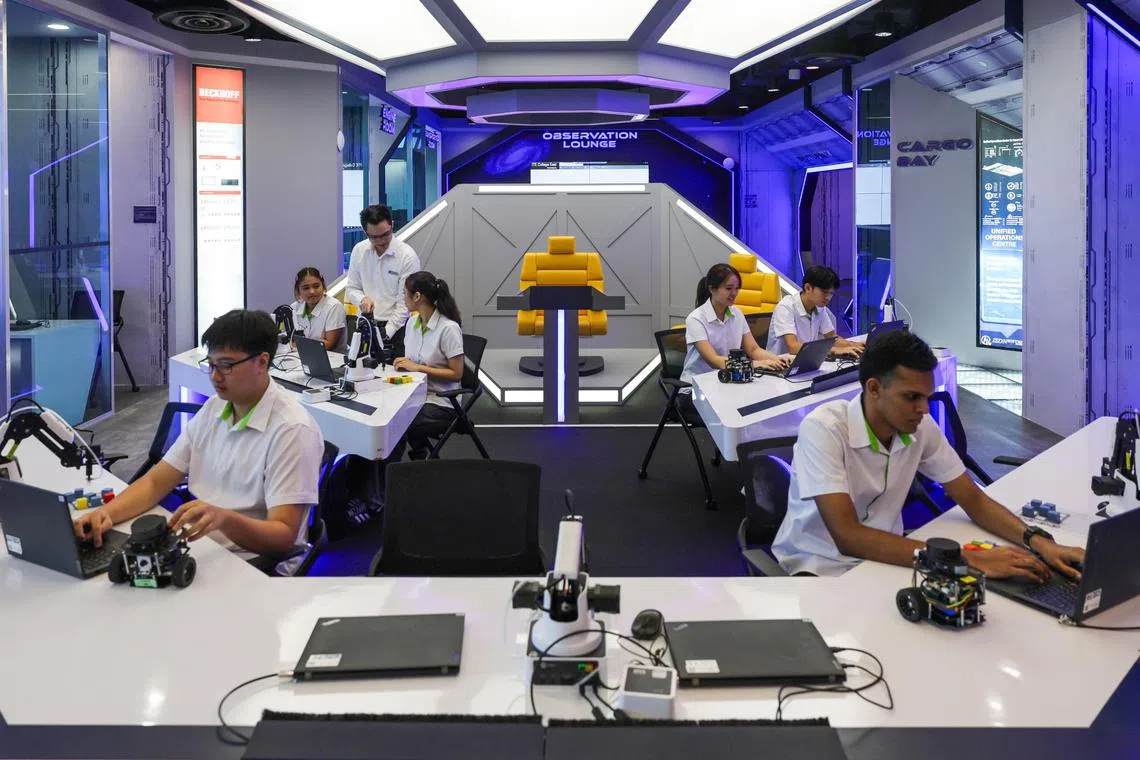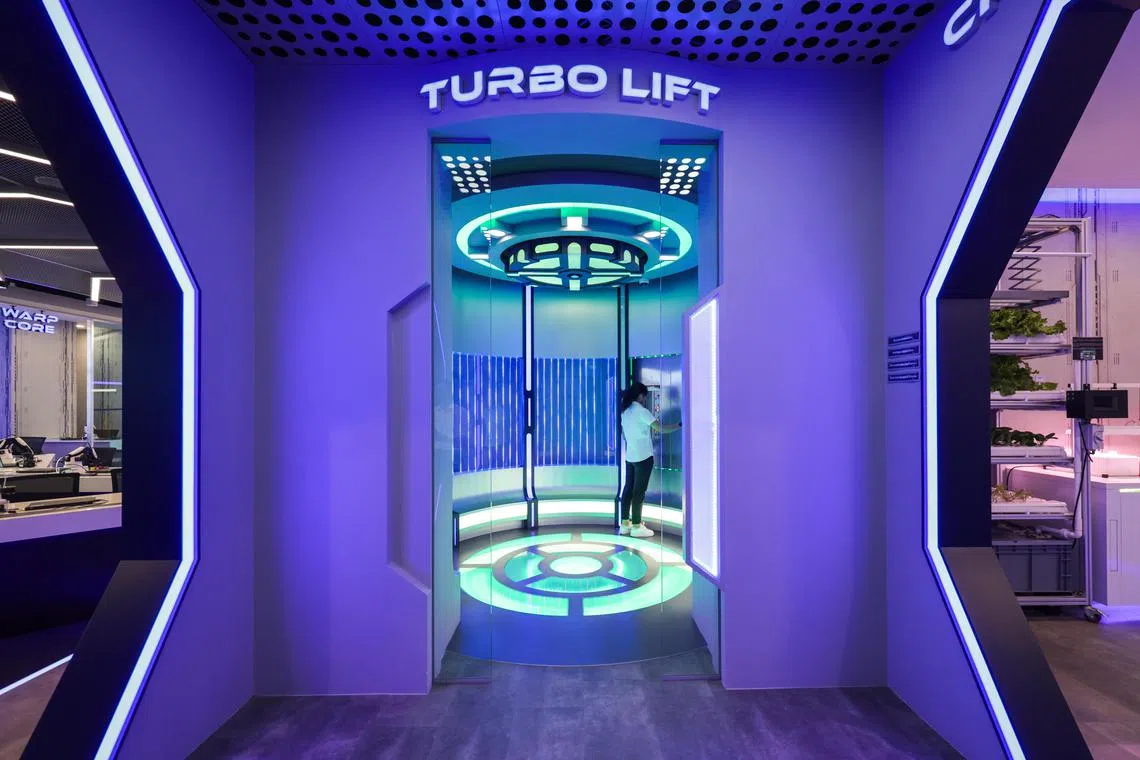ITE facilities upgrade: Preparing students for the future of tech at ITE College East
Sign up now: Get ST's newsletters delivered to your inbox

With its sleek, sci-fi inspired design and high-tech training areas, the revamped facility is changing the way students learn about electronics and automation.
ST PHOTO: GIN TAY
Follow topic:
SINGAPORE – Beam me up, Scotty!
The iconic phrase from Star Trek pops to mind when one enters a certain ITE College East lab, which has been modelled after the starship Enterprise from the science-fiction TV series.
With its sleek, sci-fi-inspired design and high-tech training areas, the revamped facility is changing the way students learn about electronics and automation.
The lab makes learning interactive and exciting, said Mr Austin Wu, senior lecturer at the School of Electronics and Info-Comm Technology, with students feeling like they are boarding a spaceship for an exciting mission.
As Star Trek’s Captain James T. Kirk would say: “To boldly go where no man has gone before.”
The transformation of the Connectivity Solutions Lab began in 2021, when the Institute of Technical Education saw the need to update its learning spaces to keep up with modern industry trends.
What was once a regular classroom has now become a high-tech training ground where students can practise their skills in different zones that replicate real-world applications.
The revamped lab, officially launched in 2023, had its newest upgrade – a smart home technology program by security and investigations company Fermax – installed in November 2024.
ITE College East also upgraded its HortiTech Hub in 2024, turning it into a fully automated high-tech indoor farm.
In this second instalment of a three-part series, The Straits Times has a closer look at how all three ITE campuses have updated their facilities to keep up with evolving industry needs and deepen student learning.
Connectivity Solutions Lab
A special training space for students in the Higher Nitec in electronics engineering course, the Connectivity Solutions Lab allows hands-on experience with smart systems, automation and modern technology.
Mr Wu told ST that he envisioned it as a space where students could practise real-life applications before theory for better understanding, as well as have an aesthetically exciting environment to engage them further.

Ms Wong Tze Yu Viola, 19, at the Turbo Lift in Connectivity Solutions Lab at ITE College East.
ST PHOTO: GIN TAY
“Traditionally for electronics, we teach them programming, as well as how the resistor and capacitor work. But if we do theory from the beginning, it will be quite dry. So instead, we show them the real-life application in the lab, before we dive into the tutorial,” said Mr Wu, adding that students learn better that way.
The Main Bridge and Observation Lounge feature smart lighting used in factories and robot arms that students learn to program, while the Cargo Bay demonstrates logistics systems used in warehouses.
The Engine Room teaches students about safety systems, and the Medical Bay introduces them to healthcare technology through medical sensors and wearable devices.
A key highlight of the lab is the Crew Quarter, designed to function like a modern smart home.
It includes a sleeping capsule, hydroponics systems for growing food without soil, and a smart home set-up created with industry partners like Fermax.

Mr Tia Kea Hin, 18, entering the password into the smart lock at the Crew Quarter, a smart home set-up at the Connectivity Solutions Lab at ITE College East.
ST PHOTO: GIN TAY
Providing a real-life experience of smart home technology, personalised settings allow students to control and automate household devices, such as adjusting lighting with a simple code, while learning about cyber security and data protection.
Mr Tia Kea Hin, 18, a first-year student in the Higher Nitec in electronics engineering, told ST that as a visual learner, he likes being able to observe teachers using different types of technology in the lab and trying it out for himself before reading or learning about it in theory lessons.
“In theory lessons, you learn that ‘this’ will happen. But you don’t know what will actually happen, because you did not see it happening in front of you with your own eyes,” he said.
Primarily designed for students enrolled in the Higher Nitec in electronics engineering course, the facility is also open to students in the Higher Nitec in security system integration and Work-Study Diploma (WSDip) in data centre infrastructure and operations.
With the introduction of certificate of competency programmes, the lab is expanding its reach to adult learners looking to upskill in fields such as internet of things (IoT), smart home systems and data centre operations.
Mr Wu said that the lab will be further enhanced over the years, to support deeper learning and a wider range of programmes.
“One of the key strategies is to regularly revisit and update our lab set-up to ensure it aligns with the latest technological advancements. We are dedicated to forging new industry partnerships to help expand and improve our facilities, ensuring that students are exposed to state-of-the-art solutions,” he added.
Automated farming at the HortiTech Hub
Designed to revolutionise urban farming through smart technologies, the HortiTech Hub, spanning approximately 90 sq m, features automated farming processes from seeding to harvesting, with minimal human intervention.
Mr Gregory Hogan, lecturer at the School of Engineering, said that with limited land in Singapore for traditional agriculture, urban farming maximises available space through vertical farming, indoor systems and automation technologies.

Mr Muhammad Ariff and Mr Gregory Hogan at the automated seeding station for microgreens and leafy greens at the HortiTech Hub in ITE College East.
ST PHOTO: GIN TAY
“Automated farming enhances precision, consistency and scalability. Unlike traditional methods, which rely on manual labour and natural environmental conditions, automation ensures controlled environments for optimal growth,” he added.
Upgraded in 2024, the hub now features robots that streamline a variety of tasks such as seeding, watering, harvesting and even inspection of plants to monitor their health and check for abnormalities.
Students learn to operate and program these robots, and acquire skills to incorporate the IoT and artificial intelligence (AI) to monitor the growth of plants for yield improvement.
The hub primarily grows microgreens and leafy greens such as kale and bok choy, which are fast-growing and nutrient-dense crops suitable for indoor farming.

Dwarf tomato cultivated at the HortiTech Hub in ITE College East.
ST PHOTO: GIN TAY
The space is used once a week by Nitec in mechanical technology students, for their sustainable engineering in agriculture and aquaculture course. It is used more frequently by students in the Higher Nitec in mechanical engineering course and WSDip in agriculture and aquaculture technology.
Mr Muhammad Ariff, 26, a WSDip trainee, works as an agri input operator at Commonwealth Greens Alpha, a local high-tech indoor farm.

Mr Muhammad Ariff and Mr Gregory Hogan at the automated seeding station for microgreens and leafy greens at the HortiTech Hub in ITE College East.
ST PHOTO: GIN TAY
He said that although not all the technology he learns about at the hub is available at his workplace, he feels that learning about automated processes and integrating AI into urban farming is very useful.
“Manual seeding takes a lot of time. You need steady hands, and you have to manually put every seed in one by one. With automation, you reduce the time it takes and the possibility of errors.”
Drones and robot companions at ITE Centre for Healthcare Simulation Training
Apart from learning how to manage patients and complex clinical events, nursing students at ITE College East are now able to incorporate technology and healthcare in a home setting.
With the introduction of the Smart Home in 2021 – a home setting incorporating technology and healthcare – students learn how to program Temi the robot to meet patient needs. These include reminding patients to take their medication, facilitating teleconsultation and even providing entertainment.
This space also has a drone that can deliver medication directly to a patient at home.

An ITE student speaking to Temi, a robot patients use for remote consultations during a demonstration at ITE College East.
ST PHOTO: GIN TAY
Mr Wong Kwok Tong, lecturer in the health science department, said that these innovations enhance the learning experience by showcasing practical, real-world applications of healthcare technology.
Although Temi the robot is currently available only in nursing homes, and drones are yet to be used in Singapore to deliver medication, Mr Wong told ST that it is important for nursing students to understand the many possibilities of technology in healthcare.
“Nowadays, there is a lot of advanced technology. So it’s very important that we actually incorporate this type of technology in our training, for students to learn,” he said.
Elisha Tushara is a correspondent at The Straits Times, specialising in Singapore’s education landscape.


